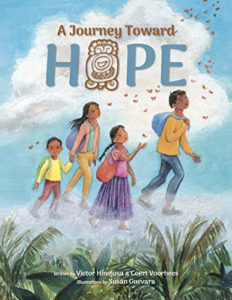“The Global Hunger and Migration Project”
When we began the Global Hunger and Migration Project, we wanted to understand why some 850,000 children and families were leaving their homes in Central America and coming to the United States to request asylum. The journey to the U.S. is incredibly long: between 1200 and 2500 miles from the most common border crossing in Mexico to most destinations at the U.S. border. It is also incredibly dangerous, and the refugees know the dangers long before they set out on the journey. They know all about the horrors of La Bestia (the train they will hop aboard for some of the way) and the people waiting to rob them and take advantage of them along the way. They all know people who’ve made the journey – they’ve heard the stories. Yet they come anyway. Why?
We’re still learning a lot about that. We’re learning about violence in their home countries and terrible choices their families are making in attempt to keep them safe. We’re learning about food insecurity and despair (and about drought and climate change that is causing some of it).
We’re also learning how hard it is to know something well. And how important it is to do the hard work of knowing something well. My students learned early on just how complex the crisis is and that in order to make a difference on one aspect of it, we needed to understand how that one thing fits into the bigger picture. We’ve also learned that failure is part of the process and we’ve had great ideas that we just couldn’t quite figure out how to get off the ground. But you can’t let fear of failure stop you from trying.
We’ve learned that we can make a difference. All of us. When we work hard and bring out talents and creativity and passions to a project, and work together, we can do more than we ever thought possible. We’re convinced – even more convinced now than when we started – that we can help make things just a little bit better. And that’s enough.
Mostly we’ve learned that it begins with empathy. With meeting people who’ve made the journey. Most often this comes from reading stories and interviews and accounts of the journey. But a spring break service-learning trip let some of my students meet and interact with refugees who had already made it to the United States. My students have learned that though these refugees come from other countries and have different experiences and may speak a different language and share a different culture, they’re not all that different from you and me. And when you meet these children and families, well, you want to do the hard work of knowing the situation well and making a difference.
We wanted you to meet some of the amazing children we met. Nando and Alessandra and Rodrigo and Laura are a lot like the children we met in our studies. We hope when you meet them you will find where you want to make a difference. Most of my students, like most of you, will not spend their lives working with refugees. I hope they’ve learned to love learning, and to love using what they know in the service of others. What do you want to learn to do well? How will you help others?
Published July 7th, 2020 by Six Foot Press
About the Book: Every year, roughly 50,000 unaccompanied minors arrive at the US/Mexico border to present themselves for asylum or related visas. The majority of these children are non-Mexicans fleeing the systemic violence of Central America’s “Northern Triangle”: Honduras, El Salvador, and Guatemala.
A Journey Toward Hope tells the story of Rodrigo, a 14-year-old escaping Honduran violence; Alessandra, a 10-year-old Guatemalan whose first language is Q’eqchi’; and the Salvadoran siblings Laura and Nando. Though their reasons for making the journey are different and the journey northward is perilous, the four children band together, finding strength in one another as they share the dreams of their past and the hopes for their future. Written in collaboration with Baylor University’s’ Social Innovation Collaborative, A Journey Toward Hope is a celebration of their humanity and an ode to the power of hope and connection even in the face of uncertainty and fear.
About the Authors:
Victor Hinojosa, Ph.D., is Associate Professor of Political Science in the Honors Program at Baylor University where his primary research is in Latin American Politics and U.S.-Latin American relations. His articles have appeared in scholarly books and journals including Terrorism and Political Violence, Political Science Quarterly, the Journal for the Scientific Study of Religion, and the Mennonite Quarterly Review. Dr. Hinojosa currently directs the Global Hunger and Migration Project, a social innovation laboratory at Baylor University that is bringing together an interdisciplinary team of faculty and students to address the challenges of child migration from Mexico and the Northern Triangle of Central America (Guatemala, Honduras, and El Salvador).
Coert Voorhees is the author the novels On the Free, In Too Deep (2013 Junior Library Guild Selection), Lucky Fools (2012 Junior Library Guild Selection), and The Brothers Torres (2009 ALA Top Ten Best Books for Young Adults), as well as the picture book Storm Wrangler. He has been a Fulbright scholar in Chile and Visiting Writer in Residence at Rice University, and he now lives with his family in Houston, Texas.
Thank you for showing us how we can make a difference and what you are doing to do so also!





1 thought on “Author Guest Post: “The Global Hunger and Migration Project” by Victor Hinojosa and Coert Voorhees, Authors of A Journey Toward Hope”